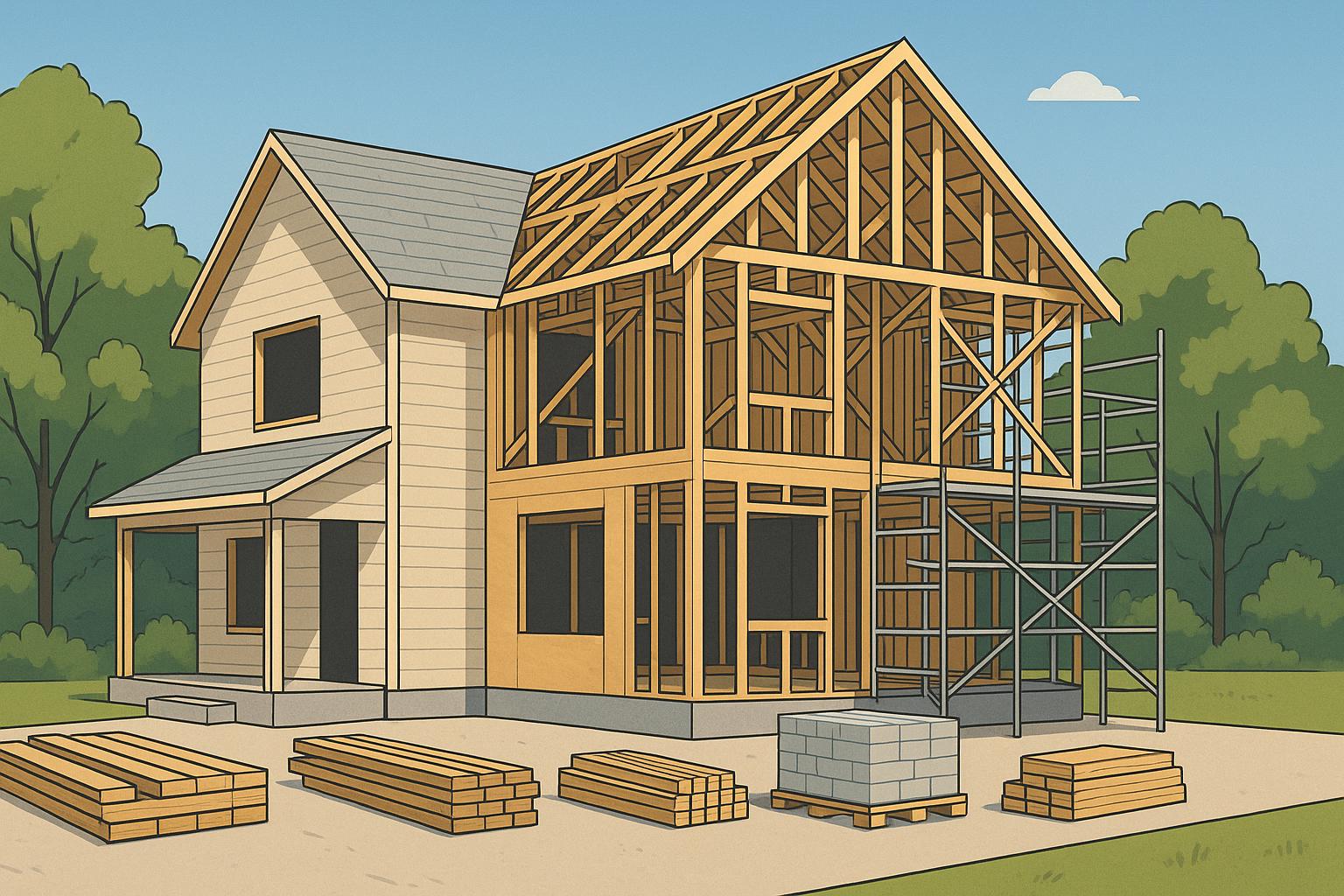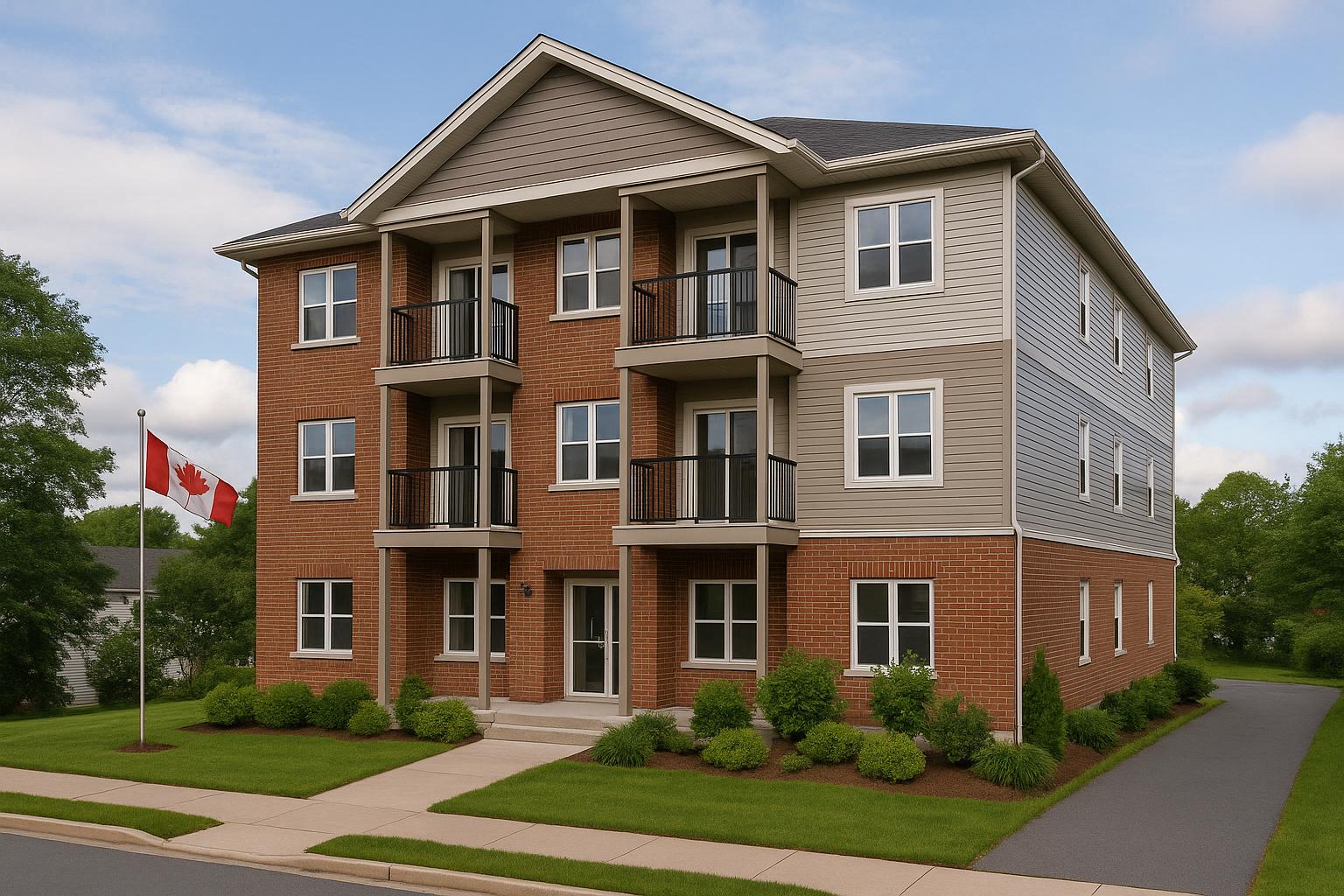Halifax is tackling its housing crisis with ER-3 zoning, a new approach that allows single-family lots to be converted into multi-unit properties like duplexes and fourplexes. This method increases housing availability while preserving neighbourhood character. Key highlights include:
- Housing Density: ER-3 zoning bridges the gap between single-family homes and large apartment complexes, addressing the "missing middle."
- Zoning Changes: Relaxed rules on lot coverage, height, and bedroom limits make construction more practical.
- Property Owner Benefits: Multi-unit conversions can generate rental income with returns of 12–20% annually.
- Community Impact: New units integrate with existing infrastructure, spreading housing solutions across the city.
ER-3 zoning offers property owners a chance to increase rental income while helping Halifax address its housing challenges.
What ER-3 Zoning Means for Housing Density
ER-3 Zoning Basics
ER-3 zoning marks a new direction in Halifax's approach to residential development. Unlike traditional single-family zoning, this category allows for multi-unit dwellings - like triplexes and fourplexes - on a single lot, addressing the gap between detached homes and large apartment complexes. This type of housing, often referred to as "missing middle" housing, provides a much-needed alternative for growing communities.
Compared to the more restrictive ER-1 and ER-2 zones, ER-3 enables moderately denser housing options, including small apartment buildings. It acts as a bridge between low-density neighbourhoods and larger-scale developments, offering a thoughtful increase in housing capacity.
What makes ER-3 zoning stand out is its emphasis on balancing growth with neighbourhood character. While it opens the door to additional housing, it also requires designs that align with the look and feel of the surrounding area. This ensures that new developments integrate smoothly into existing communities, maintaining the charm and appeal of established neighbourhoods.
These foundational principles of ER-3 zoning pave the way for regulatory changes aimed at making multi-unit construction more practical and appealing.
Key Zoning Changes for More Housing
ER-3 zoning introduces several updates that simplify the process of building multi-unit homes while keeping community needs in mind. For instance, lot coverage rules now allow for more flexible building footprints while still maintaining green spaces and parking areas.
One of the most impactful changes is the removal of restrictive bedroom limits. In the past, zoning rules imposed strict caps on the number of bedrooms, which often made it challenging to design homes suitable for larger families. ER-3 eliminates these caps, giving property owners more freedom to create housing that meets market demands and accommodates diverse household sizes.
Height restrictions have also been adjusted to ensure new buildings fit harmoniously with the surrounding homes, preserving the overall neighbourhood scale.
Additionally, ER-3 zoning focuses on architectural compatibility rather than rigid uniformity. This means new developments are encouraged to include design elements - like rooflines, windows, and materials - that complement the existing streetscape, without being overly prescriptive. The goal is to enhance neighbourhood aesthetics while allowing for creative and functional designs.
These changes not only make construction easier but also bring real benefits to Halifax, as outlined below.
Why ER-3 Zoning Helps Halifax
ER-3 zoning offers a practical solution to Halifax's housing challenges by integrating multi-unit options into established neighbourhoods. Instead of concentrating new developments in a few high-density areas, this approach spreads housing more evenly across the city. This helps increase the housing supply while avoiding strain on local infrastructure.
Another advantage is the efficient use of existing services. New multi-unit buildings can connect to already established water, sewer, and electrical systems, reducing the need for costly upgrades. Residents also benefit from access to current schools, transit routes, and community facilities, all while keeping municipal budgets in check. For property owners, the potential for increased rental income adds to the appeal.
ER-3 zoning also promotes diversity in housing options within neighbourhoods. By accommodating young professionals, families, and seniors, these developments strengthen community ties and support local businesses, fostering a more vibrant and stable environment for everyone.
How Property Owners Benefit from ER-3 Zoning
What You Can Build Under ER-3
ER-3 zoning regulations have opened up new possibilities for property owners, offering more flexibility than traditional single-family zoning. With ER-3, owners can consider a variety of construction options, such as multi-unit buildings or secondary dwelling units. This means you can adapt your property to suit its size and the community's needs, whether that’s by adding a small rental unit or creating a larger multi-unit development.
Financial Returns for Property Owners
Turning a single lot into a multi-unit rental property can have a major impact on your income potential. For example, a fourplex where each unit rents for an average of $1,950 per month could generate approximately $7,800 monthly. With construction costs averaging $160,000 per unit (or $640,000 total for four units), you’d be looking at an annual rental income of around $93,600. That translates to a solid return on investment, estimated between 12–20%.
Beyond the numbers, ER-3 zoning allows you to make the most of your existing land. Instead of buying new properties to grow your rental portfolio, you can focus on maximizing what you already own. This approach not only saves on acquisition costs but also helps stabilize cash flow. With multiple units generating income, the financial impact of occasional vacancies becomes much easier to manage.
Fitting Into Your Neighbourhood
One of the key strengths of ER-3 zoning is its emphasis on blending new developments with the existing community. This ensures that any new units built align with the character of the neighbourhood, helping to maintain property values and the overall aesthetic of the area. It’s a win-win for both property owners and the broader community.
How to Use ER-3 Zoning to Build Multi-Unit Rentals
Check If Your Property Qualifies
First, confirm whether your property is eligible for ER-3 zoning. You can do this by using the interactive map available on shapeyourcityhalifax.ca or by reaching out to HRM Planning & Development at planhrm@halifax.ca [1].
ER-3 zoning typically applies to properties located near major roads or transit routes [1]. This zoning allows for up to three units and townhomes [1], making it a great opportunity for smaller-scale multi-unit rental developments. Knowing these parameters early will help you shape your project goals effectively.
Once you've confirmed eligibility, the next step is to dive into the design rules and understand the permits required for your project.
Design Rules and Permit Process
After ensuring your property qualifies, review the design standards and permit requirements outlined in the Land Use By-law [1]. This document provides specific guidelines, including limits on building height, width, setbacks, and other design elements [1].
One major advantage of ER-3 zoning is the absence of minimum unit size requirements for residential units [2]. This gives you the flexibility to design floor plans tailored to market demand. It's a good idea to consult with the planning department early on to clarify the building envelope requirements and zoning interpretations [2]. Addressing these details upfront can save you both time and money before you finalize detailed plans.
Most ER-3 projects follow a straightforward development and construction permit process [1]. However, if your project involves variations from the strict standards outlined in the Land Use By-law, you may need Site Plan Approval. This process includes a design review by the Design Advisory Committee [1]. Keep in mind that construction must start within one year of receiving your permits and should be completed without unnecessary delays [1].
Once your permits are secured, the next step is selecting the right builder to bring your project to life.
Choosing the Right Builder
To make the most of ER-3 zoning, it's essential to work with a builder who offers an integrated design-build approach. Traditional construction methods often lead to coordination issues, which can result in budget overruns of 30–60% and extend project timelines from 8 months to over 18 months.
An integrated design-build company brings planners, architects, engineers, and construction teams together from the start. This approach minimizes miscommunication and eliminates the fragmentation that can derail traditional projects. Opting for a fixed-price construction model also protects you from unexpected costs, giving you a clear understanding of your investment upfront - typically around $160,000 per unit.
It's equally important to choose a builder familiar with Halifax's zoning requirements and experienced with HRM’s permitting process. Builders who offer guaranteed timelines, with financial penalties for delays (such as $1,000 per day), demonstrate a strong commitment to delivering your project on time.
Lastly, ensure your builder has robust quality control measures and offers comprehensive warranties. By working with a single, accountable partner, you'll streamline the process and increase the likelihood of completing your project on schedule and within budget.
Avoiding Construction Problems with Integrated Building
Problems with Fragmented Construction
If you're constructing multi-unit rentals under ER-3 zoning, you've likely encountered the headaches of managing fragmented construction. Coordination becomes a nightmare when you're juggling multiple specialists - each with their own schedules, priorities, and contracts. The result? Delays that stretch well beyond your timeline and budget overruns that can soar by 30–60%. Without a single point of accountability, you're left to untangle change orders and unexpected fees, adding stress and uncertainty to your project. That's where the integrated design-build approach comes in to simplify the process.
How Integrated Design-Build Works Better
Integrated design-build takes the chaos out of construction by combining planning, architecture, engineering, and construction into one streamlined process. With a single company handling every stage of your project, accountability is crystal clear. If delays occur, financial penalties ensure the timeline stays on track. Budget overruns? Not with fixed-price contracts that eliminate surprises. For example, projects are typically priced at $160,000 per unit and completed in just six months. Plus, you'll stay in the loop with daily photo updates and a dedicated project portal, giving you peace of mind every step of the way.
Fragmented vs. Integrated Construction Methods
Here's a side-by-side comparison to highlight the differences between these two approaches:
| Aspect | Fragmented Construction | Integrated Design-Build |
|---|---|---|
| Accountability | Multiple contracts lead to unclear responsibilities | One company handles everything |
| Timeline | An 8-month project can stretch to 18+ months | Guaranteed 6-month completion with delay penalties |
| Budget Control | Cost-plus pricing often leads to 30–60% budget overruns | Fixed-price contracts prevent unexpected costs |
| Coordination | Owners must manage separate professionals | A unified team works seamlessly together |
| Quality Control | Standards vary across different trades | Consistent quality backed by comprehensive warranties |
| Communication | Conflicting updates from multiple contacts | One point of contact with daily progress updates |
| Risk Management | Owners bear most of the coordination risks | The construction company takes on project risks |
ER-3 Project Examples and Results
Fourplex Projects That Worked
Real-world ER-3 projects in Halifax show that increasing housing density can benefit both property owners and the community. Helio Urban Development is leading the charge, with 31 units under construction and another 131 in the planning stages.
These fourplex developments have proven to be financially reliable, offering steady returns. For instance, rental income for a two-bedroom unit ranges from $1,950 to $2,100, resulting in an annual return on investment (ROI) of 12–20% on a $640,000 investment (or $160,000 per unit).
The construction process is efficient, with a typical timeline of just six months. This allows property owners to start earning rental income quickly, avoiding the lengthy delays often associated with traditional builds. For context, delays could mean losing approximately $8,800 per month in potential rental income.
Additionally, projects that leverage the CMHC MLI Select program significantly boost financial viability. With construction costs averaging $200,000 per unit, these energy-efficient buildings qualify for 95% financing with just a 5% down payment. This creates a financing ratio of 20:1, enabling property owners to build more units with the same initial capital while maintaining positive cash flow from the outset.
These numbers highlight not just the profitability of ER-3 projects, but also their potential to support broader community and economic goals.
Impact on Communities and Economics
ER-3 projects go beyond financial gains - they help address Halifax's housing shortage while preserving the character of existing neighbourhoods. By converting single-family lots into fourplexes, each property can accommodate three additional rental units, effectively quadrupling housing capacity compared to traditional single-family homes.
This construction isn’t limited to Halifax’s urban centre. Development is happening across municipalities within a 90-minute radius, from Antigonish to Bridgewater, spreading the benefits to a wider area. Modern designs and a Premium Rental Ready Package - including Energy Star appliances and smart home features - ensure that units are ready for tenants as soon as construction wraps up.
An integrated construction approach further enhances efficiency by eliminating an average of $47,000 in coordination waste, which is common when working with fragmented teams. On top of that, professional engineering inspections and a 2-year construction warranty ensure high-quality outcomes, protecting property values and fostering community trust.
sbb-itb-16b8a48
3306 Windsor St, Halifax, NS Presented by Assist 2 Sell, HomeWorks Realty Ltd..

Conclusion: ER-3 Zoning as Halifax's Housing Solution
ER-3 zoning stands at the heart of Halifax's push for gentle density, offering a way to transform residential land into multi-unit rental properties. This approach not only helps address the city's housing crisis but also provides property owners with the potential for a solid annual return of 12–20%. It's a win-win model - offering both financial rewards and a chance to contribute to community growth.
The combination of strong rental income potential and the benefits of CMHC MLI Select financing, as covered earlier, makes ER-3 zoning an attractive opportunity for eligible property owners. Adding to this, an integrated construction process ensures projects stay on schedule and within budget, reducing common delays and cost overruns.
Development opportunities aren’t just limited to Halifax itself. Properties within a 90-minute radius of the city can also be part of this initiative, giving Nova Scotia property owners a chance to help fill the rental housing gap while reaping financial rewards.
By using a streamlined design-build approach, ER-3 developments avoid the inefficiencies often seen in disjointed construction projects. This method ensures that both financial goals and community needs are met seamlessly.
With 31 units currently under construction and another 131 in the planning stages across Nova Scotia, the impact of ER-3 zoning is already being felt. Property owners who seize this opportunity can grow their wealth through rental income while playing a vital role in creating sustainable, moderately dense neighbourhoods that align with Halifax's housing goals.
ER-3 zoning is more than just a financial opportunity - it’s a cornerstone of Halifax’s housing strategy, blending property investment with thoughtful, community-focused development.
FAQs
How does ER-3 zoning help create more housing options in Halifax's 'missing middle'?
ER-3 Zoning in Halifax: Encouraging Gentle Density
Halifax's ER-3 zoning is designed to promote "gentle density", allowing property owners to develop up to eight units per lot. This includes options like fourplexes or smaller apartment buildings. Typically applied in areas near public transit and local amenities, this zoning approach ensures new housing integrates smoothly into established neighbourhoods.
By filling the gap between single-family homes and large apartment buildings, ER-3 zoning addresses the "missing middle" - the demand for medium-density housing. This strategy not only broadens housing choices and supports Halifax's growing population but also offers property owners a way to contribute to housing availability while earning rental income.
What financial benefits can property owners expect by converting single-family lots into multi-unit properties under Halifax's ER-3 zoning?
Converting single-family lots into multi-unit properties under Halifax's ER-3 zoning can be a smart financial move. With the ability to build up to eight units on a single lot, property owners can lower the construction cost per unit, boost rental income potential, and see a rise in property value. This zoning change also supports Halifax's efforts to tackle the housing crisis, giving owners a chance to invest in their community while achieving solid financial returns.
While there may be significant upfront expenses, such as upgrading water and sewer infrastructure, these costs are often recouped over time through consistent rental income and the long-term appreciation of the property. For those looking to expand their investment portfolio, ER-3 zoning offers a practical solution that meets Halifax's growing housing needs.
How does a design-build approach simplify building multi-unit rentals under Halifax's ER-3 zoning?
Simplifying Multi-Unit Rentals with Design-Build in Halifax's ER-3 Zoning
Using a design-build approach makes constructing multi-unit rentals under Halifax's ER-3 zoning much more straightforward. By combining the design and construction phases into one seamless process, this method can significantly shorten timelines - taking projects that might typically last 12 to 18 months and wrapping them up in as little as 6 months. It also helps sidestep common headaches like budget overruns and unexpected delays.
With only one team managing the entire project, property owners gain a clear line of accountability. This ensures everything stays on track, including meeting ER-3 zoning requirements like height restrictions and unit limits. Plus, it eliminates the hassle of juggling multiple contracts, making the entire process smoother and more efficient. Ultimately, it’s a smart way to build faster and contribute to Halifax’s growing housing needs.



